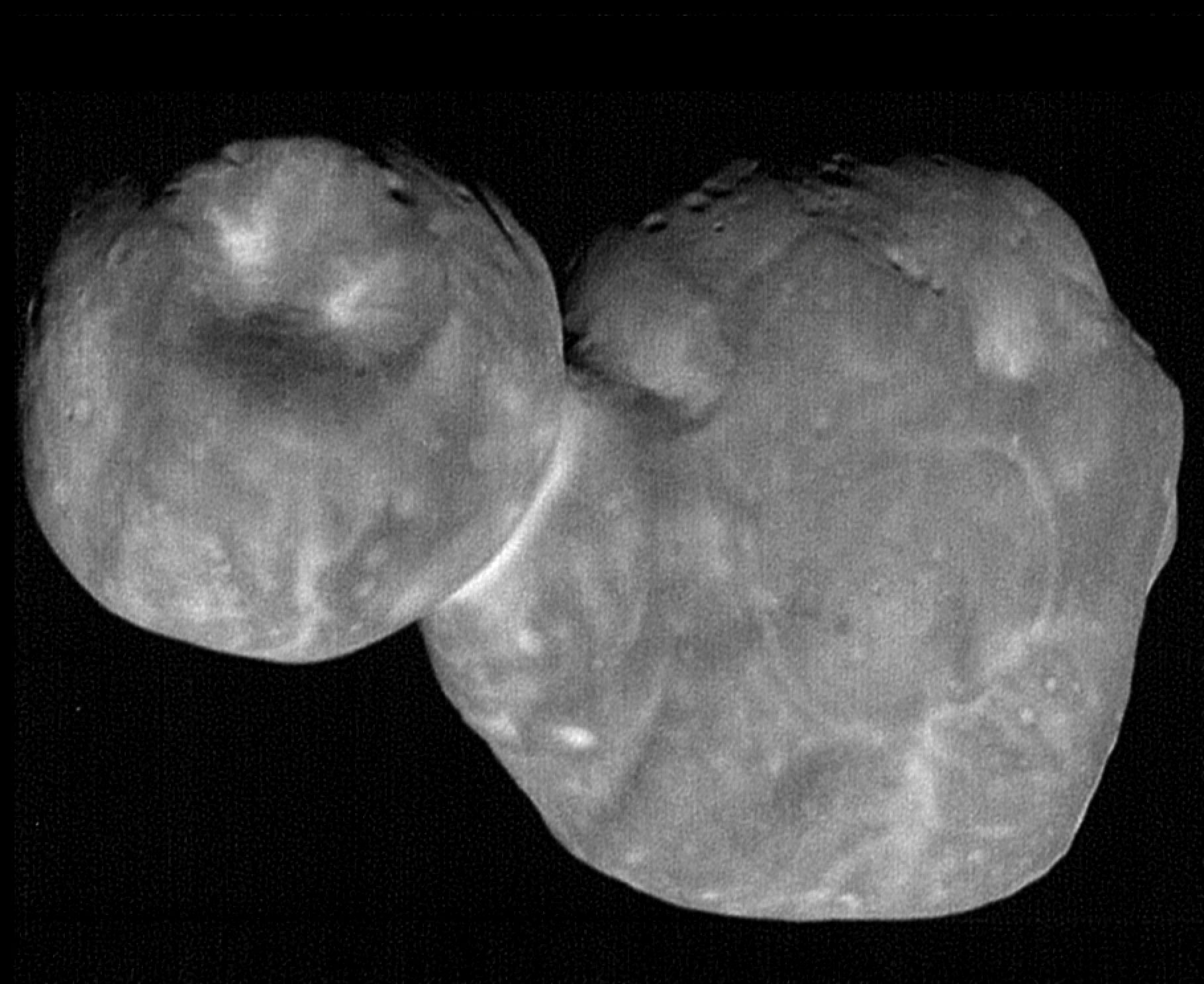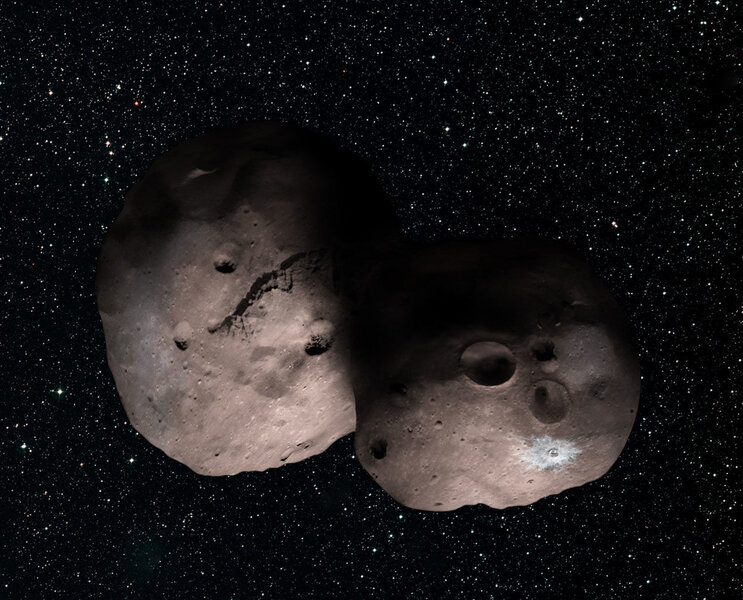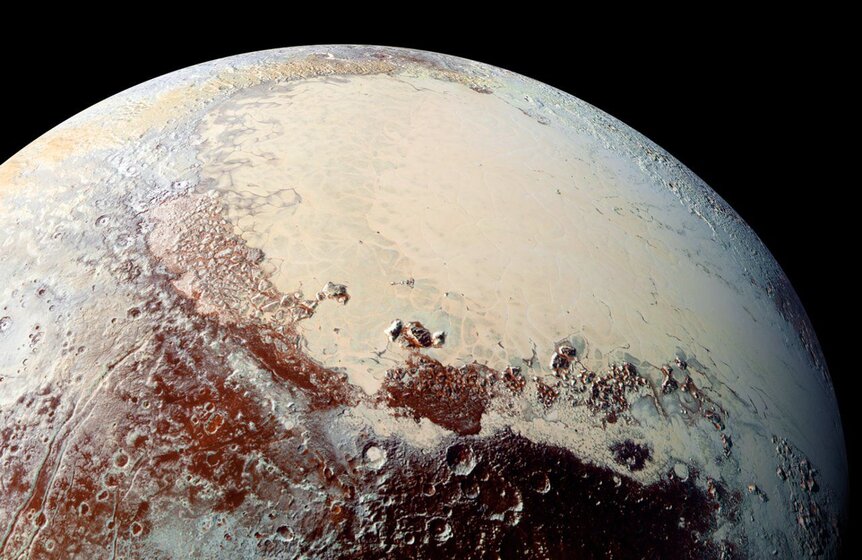Create a free profile to get unlimited access to exclusive videos, sweepstakes, and more!
Here it is: The most detailed full image of MU69 from New Horizons we'll ever see.

After the monumentally successful flyby of Pluto in 2015, the New Horizons spacecraft continued on into the outer solar system. After traveling at more than a dozen kilometers per second out an additional billion kilometers or so, it shot past the odd little rocky iceball 2014 MU69 on January 1, 2019, passing it by the razor-thin margin of just 3,500 kilometers … and that was after traveling for over 6.6 billion kilometers from Earth!
New Horizons took a lot of data during this encounter, comparable to what it did at Pluto, and it'll be another year or more before it's all back on Earth. So the New Horizons team did a clever thing: They prioritized what images to send back first. Among the highest priorities was getting the highest-resolution image sent back from the closest encounter as quickly as possible.
And now that image is here.
That is MU69, seen by New Horizons from a distance of just 6,628 kilometers away and about 6.5 minutes before closest approach. It's actually a mosaic of nine separate short exposures combined to give a resolution on the surface of an incredible 33 meters per pixel. Given that MU69 is about 32 kilometers end-to-end, that's a pretty detailed shot! It's not only the highest-resolution image of the entire object so far, it's also the highest resolution we'll ever see. This is it.
And it's amazing.
Earlier images (and even observations from Earth) showed that MU69 is what we call a contact binary, two objects connected together by a thin neck. Each object formed separately, though possibly nearby each other, and they slowly spiraled together until they contacted each other.
Weirdly, such binary structures are common in small bodies like this! A large fraction of near-Earth asteroids are binary or contact binaries, and this is also true for many other kinds of objects, too. Once you get past that, though, something else from this image is quite striking.
Or, really, not striking. That is, there aren't many craters on it. Why hasn't it been struck more by other objects in space?
First, we have to be careful: When New Horizons took this (and many other) images, the Sun was almost directly behind it. That tends to lower contrast on surface features a lot, making craters harder to spot. Compare a picture of the full Moon to one at first quarter to see how this works; when the Sun is directly behind you and fully illuminating an object (like the full Moon) there are no shadows from your perspective, making craters difficult to see. They're much easier to spot when the Sun shines at an angle and you can see shadows.
This is true for this image of MU69, too. The craters are most obvious near the upper edge, where you can see their shadows. Down near the bottom you can spot craters as circular features with slightly brighter interiors, but they're not at all as obvious.
You might think that being out there, exposed to space out past Neptune for billions of years, MU69 would be covered in craters. For Pluto that's not the case because we think its surface gets repaved, so to speak, from subsurface processes that bubble up liquid from the interior. However, MU69 is far too small for that, and is certainly solid throughout. So a dearth of craters means there must be a dearth of impactors.
Interestingly, some scientists actually predicted this! They used the number of small craters seen on Pluto and its huge moon Charon, together with measurements and estimates of sizes of small objects past Neptune (called trans-Neptunian objects [TNOs], or more specifically in this case the Kuiper Belt), first to try to figure out the size distribution of objects out there capable of hitting MU69, and then to predict the size distribution of craters on MU69. Keep in mind that this was all done before the MU69 encounter!
The conclusion they drew from their methods is that there are a lot fewer small bodies out there past Neptune than previously thought. This gets a bit complicated because orbital dynamics of TNOs has a lot of factors going into it; for example, MU69's orbit isn't inclined by much to the inner solar system (seen from edge on, it aligns decently well with Earth's orbit) whereas Pluto is tilted by a whopping 17°, so the populations of objects they get whacked by are different.
But, given that, they predicted that there wouldn't be very many small craters on MU69, saying they expect there should be about 25–50 craters bigger than 200 meters. That does appear to be close to what's seen! To my eye, judging from this new image, that number may be a bit low — I can see roughly that many craters, and we're only seeing half of MU69's surface — but that's not bad, given that there could have been, say, thousands of craters. Getting the number even in the right ballpark means they're on to something.
They mention there may not be any big craters larger than 6 km or so, noting that with small number statistics getting one or two that size wouldn't be surprising. It's hard to tell from this image alone (we'll need more images of the surface to understand the topography better), but the only really big crater I see is on the smaller lobe, and it's about 8 km across! So again, not bad.
The implications of this are amazing: Because the surface is hardly affected by cratering, and the interior isn't liquid, we are seeing a pristine surface billions of years old! There have been some modifications; the solar wind, ultraviolet light from the Sun, and even galactic cosmic rays (high-speed subatomic particles shooting around the galaxy accelerated by exploding stars) all change the chemistry of the surface, but the structure of it has probably remained unchanged since MU69 formed eons ago.
I think all of this is extremely cool, learning about what kinds of objects are out there, far far too small to yet be seen directly, by looking at how they're impacting other objects. It'll be very interesting when more high-resolution images are returned from New Horizons, especially taken at different angles to enhance contrast and changes in topography (hills and valleys and such). Accurate crater counts will provide a lot of insight into what's going on out there in the Deep Black past Neptune, where we know so very little about our solar system … but about which we're learning more every day.





























